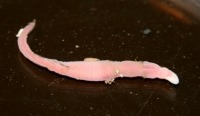
(Photo: Huntsman Marine Science Centre)
Ribbon Worm
Micrura sp.
Worm with a ribbon-like body (hence their common name, ribbon worms). There are many species but they are hard to tell apart. Can have many colourations and patterns. It is not possible to identify this specimen to species level. One possibility is Micrura affinis. This is the only Bay of Fundy species with ocelli (eye spots). It is red with cream edges and can reach 15 centimetres in length.
Authority
Ehrenberg, 1828
Classification Details
Phylum: Nemertea (ribbon worms); Class: Pilidiophora
Habitat
Live in soft seabeds such as sand and mud. Also found on algae and hydroids. Many species are found on the shore but can be found down into the bathypelagic zone (1 000 to 4 000 metres). Micrura affinis is found from Cape Cod to Newfoundland. It is found on the shore and shallow subtidal, including estuaries.
Diet
Most ribbon worms are carnivorous. They may consume only their prey's body liquid or the entire prey item. Species with smaller mouths feed on protozoans. Larger species can consume prey up to their own body size. Other species in this genus eat bristle worms and other ribbon worms.
Reproduction
Sexes are separate. Individuals develop rows of gonads on the inside of their bodies. These produce eggs or sperm. When they are ready to be released, the worm forms gonad ducts, which are then reabsorbed after release. Fertilization is external. A miniature worm hatches from the fertilized egg.
Fun Facts
The ribbon worm Lineus longissimus is thought to be the one of the longest animals on the planet. It can reach 60 metres in length - longer than the blue whale!
References
Frost E (2013) 14 fun facts about ribbon worms. Smithsonian Magazine https://www.smithsonianmag.com/science-nature/14-fun-facts-about-marine-ribbon-worms-3156969/ Accessed on 20 November 2020. Gibson R (2001) Phylum Nemertea (Nemertinea, Nemertini, Rhynchocoela). In Keys to the marine invertebrates of the Woods Hole region (Smith RI ed) Availble from http://comm.archive.mbl.edu/publications/biobull/keys/7/index.html Accessed on 20 November 2020. Pollock LW (1998). A practical guide to the marine animals of northeastern North America. Rutgers University Press. New Brunswick, New Jersey & London. 367 pp.,

